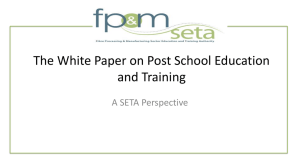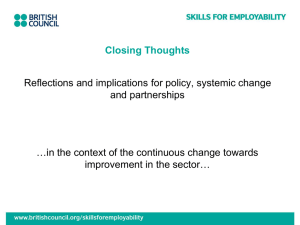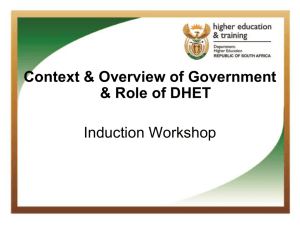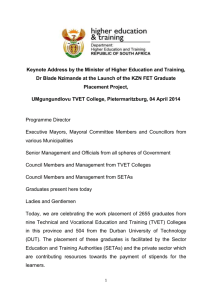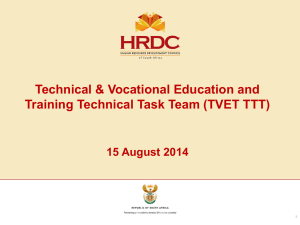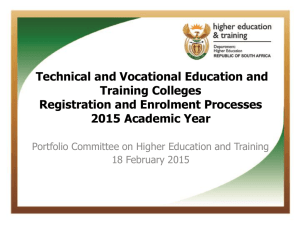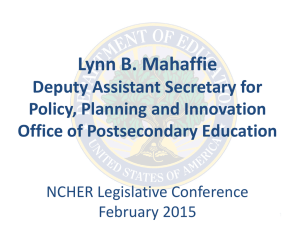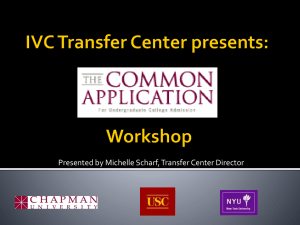Post-school Education &Training in South Africa
advertisement
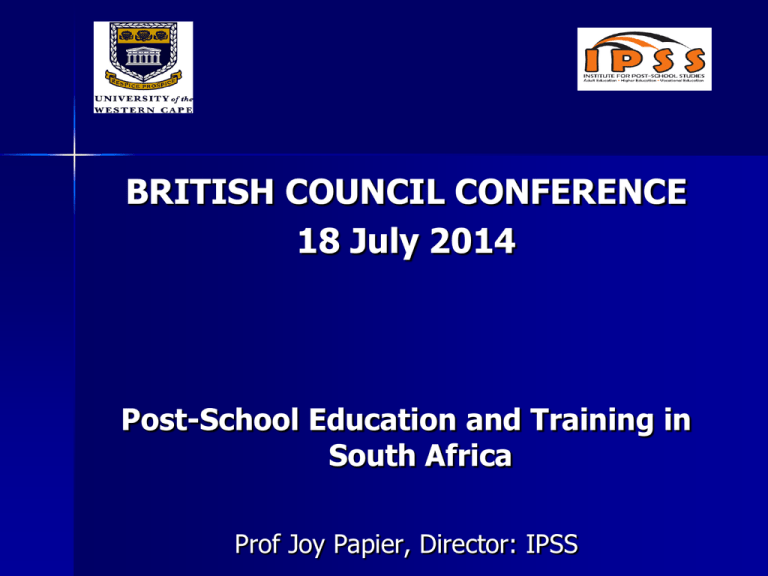
BRITISH COUNCIL CONFERENCE 18 July 2014 Post-School Education and Training in South Africa Prof Joy Papier, Director: IPSS Policy direction the policy environment for post-schooling receives decisive direction from the White Paper for Post-School Education and Training (2014) discourse: coherence, coordination, integration, access, quality, articulation, differentiation, partnerships, sustainable livelihoods, expansion… Policy environment policy creates an enabling environment strongly favours the idea of partnerships aligned to National Development Plan, New Growth Path, Industry Policy Action Plan and the Human Resource Development Strategy for SA Green Paper of 2012 highlighted the central role of FET/TVET colleges Caution about making FET colleges the ‘catch all’ institution colleges cannot (and should not) accommodate everyone in post-schooling who needs education and training White Paper is therefore more nuanced Community Colleges (ex Public Adult Learning Centres) to be established adults need a wide range of offerings and community related education Minister DHET at launch of the White Paper, said: “SA needs a single, coherent, differentiated, highly articulated and yet diverse, nonracial, post-school education and training system with all sectors playing their role as part of a coherent but differentiated whole”. College legacy issues uneven institutional landscape Rural/urban inequalities education for adults marginalised too few opportunities for all who need unemployment, poverty Issue of learner choice: Central admissions system mooted for HEIs Students often by-pass their local colleges Travel and accommodation costs increase How do colleges choose ‘locally appropriate’ programmes without limiting student opportunities and choice? Targets for PSET 2030 2.5 million in TVET colleges by 2030 1 million adults in community colleges 1.6 million enrolments in university 30 000 artisans trained per year 12 new campuses by 2015 2023 – at least one institution offering TVET programmes in every district Purpose of TVET Colleges Purpose of FET colleges – White Paper changes name to TVET colleges p.16: “the main purpose of the TVET colleges is to prepare students for the workplace and/or self-employment, and it is essential that they develop and maintain close working relationships with employers in their areas of study”. Strengthening public TVET Colleges Programmes to be streamlined and offered in more modes eg. part-time Student financial, academic and emotional support Lecturer capacity development, formal qualifications, proper remuneration system Management structures Systems to enable partnerships Colleges still face many challenges Different levels of expertise in management, governance, learner readiness, financial expertise, partnerships management Some colleges still under administration, others have started turnaround Changes occur over time – no quick fixes The White Paper and Partnerships institutions have to break out of silos colleges have had to work hard on partnerships irony is that many colleges have successful overseas relationships but battle locally SETAs should play a role in facilitating relationships and incentivise employers SETAs to establish offices at colleges – colleges should seize these opportunities Youth Employment Accord – to connect young people to employment – job placements Government depts to employ interns SETAs asked to be pro-active towards youth Small Enterprise Finance Agency and Small Enterprise Development Agency Youth unemployment seen as urgent national challenge SETA roles DHET and SETAs to map supply and demand more funds for discretionary grants – 80% of this for professional, vocational, technical and academic learning (PIVOTAL) programmes that lead to qualifications/industry awards SETAs to provide incentives for companies to take in learners for work placement SETAs and TVET colleges to design programmes for scarce skills What is necessary for partnerships? stability – migration finalised; councils; managers instead of administrators; financial systems – inspire confidence in sector colleges have to look for and attract partners What is necessary for partnerships? (continued) liaison and partnerships personnel encourage staff to be ‘outward looking’ quality teaching and curricula for innovation

